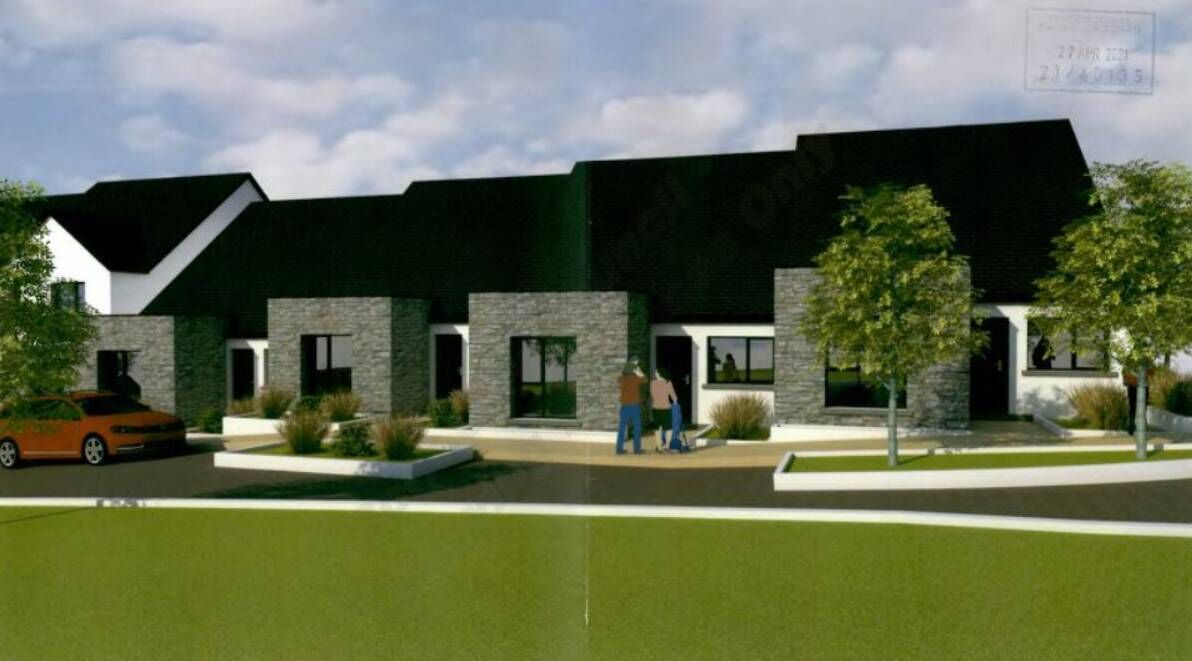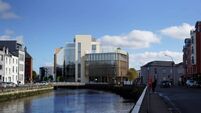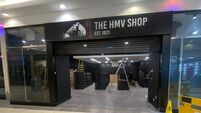Dire predictions about the ‘future of the office’ prove largely unfounded

A double-decker bus passes Navigation Square by O'Callaghan Properties (OCP), Albert Quay. Block One in the development sold during 2021 for €60m.
IT is fair to say that considering the challenging backdrop, the Irish commercial property market performed considerably better than anyone expected in 2021.
At the beginning of the year, there were concerns about altered shopping, living, working, and socialising habits and how these might impact different sectors of the market. This was before the market was forced into additional phases of lockdown which delayed construction activity and hampered recovery in particular sectors of the market, not least the retail, leisure, and hospitality sectors.
The inability of investors and occupiers to travel to inspect opportunities had a profoundly negative impact on activity in the office and retail occupier markets and in the investment sector during the first half of the year.
However, once lockdown measures eased in the summer, the pace of leasing velocity improved in all occupier sectors and in the development land market. There was also signs of greater momentum in the investment market from the summer months onwards.
Indeed, activity and transaction volumes in all sectors were considerably better in the second half of 2021 than they were in the first six months of the year, and we began to see some appetite for well-priced retail opportunities also.

Transaction volumes in Q3 were more than double the first two quarters combined in many sectors, such was the resurgence in occupier and investor activity witnessed.
With the exception of the trophy Cork investment sale of 2021 — that being the sale of the 1 Navigation Square office building for €60m — investment volumes in Cork were considerably lower than normal.
However, as in Dublin, there was a discernible increase in momentum in the second half of the year, which bodes well for a welcome recovery in both occupier and investor activity in this region in 2022.
The focus over the last 12 months in Cork has firmly been on planning and development activity, with applications for several exciting schemes, not least O’Callaghan Properties’ ambitious plan to revitalise the south docklands that was announced late last year.
Rents and yields in all sectors of the commercial property market began to stabilise during the second half of the year, albeit some sectors of the market fared better than others.
Very significant variances between sectors continued to prevail throughout 2021, with the industrial and logistics sector being the clear out-performer of the commercial property market, boosted by increased demand as a result of Brexit as well as the Covid-19 pandemic, as an increasing number of occupiers sought to bring more of their storage and distribution activities in-country.
Prime industrial and logistics buildings in all locations were in short supply as a direct result. Occupier activity was robust, while investment spend on industrial and logistics properties set a new record in the Irish market during 2021, mirroring trends witnessed elsewhere in Europe.

Prime industrial yields also hit a new record during the year.
Despite dire predictions about the ‘future of the office’, job creation and office-based employment continued to grow throughout 2021 with several job announcements made during the year.
While take-up volumes year-to-date remain below par, by year-end 2021, office requirements in the capital had reverted to pre-pandemic peaks, with many occupiers confident to proceed with location and expansion decisions.
There were also signs of renewed appetite for office accommodation in the Cork market which will see some transactions completing in the early part of 2022.
While there is good visibility on active requirements, the speed at which this demand will translate into completed deals is largely dependent on the trajectory of Covid-19 and when Government guidance suggests that it is safe for all occupiers to return to offices. Last year also saw a record volume of investment in Ireland’s healthcare sector, with investors looking at a myriad of different types of transactions and resorting to development in order to secure nursing-home stock in some cases.
We also saw some renewed interest in hotel investment properties and purpose-built student accommodation — a trend that is likely to gather pace in 2022. Last year saw institutional investors focusing considerable attention on opportunities in the residential sector in Europe, encouraged by the extent to which this sector demonstrated its resilience throughout the pandemic.
There were several new entrants to the Irish multifamily market throughout 2021, attracted by a combination of economic and demographic factors, as well as the severe shortage of affordable housing of all types and tenures.
In the absence of standing stock, many of these investors opted to pursue forward-commitment and forward-fund transactions in an effort to access stock and deliver much-needed new accommodation.
One of the biggest issues currently facing the Irish Government is the severe imbalance between supply and demand in the housing sector, and in this vein, it is critically important that we continue to facilitate investment and delivery.
Without international capital and collaboration between the public and private sectors, the ability to deliver on the Government’s ambitious Housing for All objectives will be compromised.
Although Covid-19 looks certain to dominate headlines for some time yet, we are confident of a further pick-up in activity in the Irish commercial property market in 2022.
The proportion of capital allocated to real estate has grown exponentially, and this will increase further over the course of the next 12 months as inflationary pressures escalate.
With construction severely constrained since the onset of the pandemic, 2022 will hopefully see a number of new schemes commencing on-site as the market gears up for the next cycle.
Marie Hunt is executive director at CBRE Ireland









